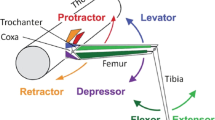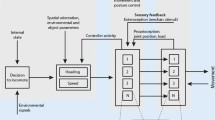Abstract
Stick insects (Cuniculina impigra) possessing only one front leg with restrained coxa performed searching movements or “walked” on a treadband. The movements are described. Ablation, surgical manipulation or experimental stimulation of different sense organs (femoral chordotonal organ, campaniform sensilla on trochanter and femur basis, proprioceptors at the coxatrochanter joint) were performed, and the resulting changes in motor output were recorded. These experiments demonstrate that the walking- and searching-pattern generators cannot be separated, at least not for the movements investigated. This walking- and searching-pattern generator consists of central modules, each of which produces irregular alternation of the activity of motor neurones of antagonistic muscles of a single joint, and of “reflex loops”. At least some of these reflex loops are only present in the active animal. They are responsible either for the control of a single joint or for the coordination of the movements of separate joints. The performance of these reflexes does not only depend on the state of activity of the animal; some of them additionally seem to depend on the context signalled by other sense organs.
Similar content being viewed by others
References
Bässler U (1967) Zur Regelung der Stellung des Femur-Tibia-Gelenkes der Stabheuschrecke Carausius morosus in der Ruhe und im Lauf. Kybernetik 4:18–26
Bässler U (1972) Zur Beeinflussung der Bewegungsweise eines Beines von Carausius morosus durch Amputation anderer Beine. Kybernetik 10:110–114
Bässler U (1973) Zur Steuerung aktiver Bewegungen des Femur-Tibia-Gelenkes der Stabheuschrecke Carausius morosus. Kybernetik 13:38–53
Bässler U (1974) Vom femoralen Chordotonalorgan gesteuerte Reaktionen bei der Stabheuschrecke Carausius morosus: Messung der von der Tibia erzeugten Kraft im aktiven und inaktiven Tier. Kybernetik 16:213–226
Bässler U (1976) Reversal of a reflex to a single motoneuron in the stick insect Carausius morosus. Biol Cybern 24:47–49
Bässler U (1977) Sense organs in the femur of the stick insect and their relevance to the control of position of the femur-tibia-joint. J Comp Physiol 121:99–113
Bässler U (1983) Neural basis of elementary behavior in stick insects. Springer, Berlin Heidelberg New York
Bässler U (1986a) Afferent control of walking movements in the stick insect Cuniculina impigra. I. Decerebrated animals on a treadband. J Comp Physiol [A] 158:345–349
Bässler U (1986b) Afferent control of walking movements in the stick insect Cuniculina impigra. II. Reflex reversal and the release of the swing phase in the restrained foreleg. J Comp Physiol [A] 158:351–361
Bässler U (1988) Functional principles of pattern generation for walking movements of stick insect forelegs: the role of the femoral chordotonal organ afferences. J Exp Biol 136:125–147
Bässler U, Koch UT (1989) Modelling of the active reaction of stick insects by a network of neuromimes. Biol Cybern 62:141–150
Bässler U, Wegner U (1983) Motor output of the denervated thoracic ventral nerve cord in the stick insect Carausius morosus. J Exp Biol 105:127–145
Bässler U, Foth E, Breutel G (1985) The inherent walking direction differs for the prothoracic and metathoracic legs of stick insects. J Exp Biol 116:301–311
Bässler U, Rohrbacher J, Karg G, Breutel G (1991) Interruption of searching movements of partly restrained front legs of stick insects, a model situation for the start of a stance phase? Biol Cybern 65:507–514
Chrachri A, Clarac F (1990) Fictive locomotion in the fourth thoracic ganglion of the crayfish Procambarus clarkii. J Neurosci 10:707–719
Cruse H (1985a) Coactivating influences between neighbouring legs in walking insects. J Exp Biol. 114:513–519
Cruse H (1985b) Which parameters control the leg movement of a walking insect? II. The start of the swing phase. J Exp Biol 116:357–362
Cruse H (1990) What mechanisms coordinate leg movement in walking arthropods? Trends Neurosci 13:15–21
Cruse H, Dean J, Suilmann M (1984) The contribution of diverse sense organs to the control of leg movements by a walking insect. J Comp Physiol [A] 154:695–705
Dean J (1984) Control of leg protraction in the stick insect: a targeted movement showing compensation for externally applied forces. J Comp Physiol [A] 155:771–781
Delcomyn F (1991) Activity and directional sensitivity of leg campaniform sensilla in a stick insect. J Comp Physiol [A] 168:113–119
Deliagina TG, Orlovsky GN, Pavlova GA (1983) The capacity for generation of rhythmic oscillations is distributed in the lumbosacral spinal cord of the cat. Exp Brain Res 53:81–90
Foth E, Bässler U (1985) Leg movements of stick insects walking with five legs on a treadwheel and with one leg on a motor driven belt. II. Leg coordination when step-frequencies differ from leg to leg. Biol Cybern 51:319–324
Gelfand IM, Orlovsky GN, Shik ML (1988) Locomotion and scratching in tetrapods. In: Cohen AH, Rossignol S, Grillner S (eds) Neuronal control of rhythmic movements in vertebrates. Wiley, New York
Graham D, Bässler U (1981) Effects of afference sign reversal on motor activity in walking stick insects (Carausius morosus). J Exp Biol 91:179–193
Grillner S (1981) Motor control. In: Brooks VB (ed) Handbook of physiology (sect 1:The nervous system, vol 2). Williams & Wilkins, Baltimore, pp 1179–1236
Head SI, Bush BMH (1991) Proprioceptive reflex interactions with central motor rhythms in the isolated thoracic ganglion of the shore crab. J Comp Physiol [A] 168:445–459
Hofmann T, Bässler U (1982) Anatomy and physiology of trochanteral campaniform sensilla in the stick insect, Cuniculina impigra. Physiol Entomol 7:413–426
Hofmann T, Bässler U (1986) Response characteristics of single trochanteral campaniform sensilla in the stick insect, Cuniculina impigra. Physiol Entomol 11:17–21
Karg G, Breutel G, Bässler U (1991) Sensory influences on the coordination of two leg joints during searching movements of stick insects. Biol Cybern 64:329–335
Nothof U, Bässler U (1990) The network producing the “active reaction” of stick insects is a functional element of different pattern generating systems. Biol Cybern 62:453–462
Pearson KG (1985) Are there central pattern generators for walking and flight in insects? In: Barnes WJP, Gladden MH (eds) Feedback and motor control in invertebrates and vertebrates. Croom Helm, London, pp 307–315
Pearson KG (1987) Central pattern generation: a concept under scrutiny. In: McLennan H, Ledsome JR, McIntosh CHS, Jones DR (eds) Advances in physiological research. Plenum Press, New York, pp 167–185
Pflüger HJ, Bräunig P, Hustert R (1981) Distribution and specific central projections of mechanoreceptors in the thorax and proximal leg joints of locusts. II The external mechanoreceptors: hair plates and tactile hairs. Cell Tissue Res 216:79–96
Radnikow G, Bässler U (1991) Function of a muscle whose apodeme travels through a joint moved by other muscles: why the retractor unguis muscle in stick insects is tripartite and has no antagonist. J Exp Biol 157:87–99
Rossignol S, Lund JP, Drew T (1988) The role of sensory inputs in regulating patterns of rhythmic movements in higher vertebrates: a comparison between locomotion, respiration and mastication. In: Cohen AH, Rossignol S, Grillner S (eds) Neuronal control of rhythmic movements in vertebrates. Wiley New York, pp 201–283
Schmitz J (1986) The depressor trochanteris motoneurones and their role in the coxo-trochanteral feedback loop in the stick insect Carausius morosus. Biol Cybern 55:25–34
Schmitz J, Schöwerling H (1992) No effects of coxa-trochanteral proprioceptors on extensor tibiae motoneurons in posture control. In: Elsner N, Richter DW (eds) Rhythmogenesis in neurons and networks. Thieme, Stuttgart
Schmitz J, Büschges A, Delcomyn F (1988) An improved electrode design for en passant recording from small nerves. Comp Biochem Physiol [A] 91:769–772
Schöwerling H, Schmitz J (1988) Reflex activation of the levator trochanteris muscle in the stick insect, Carausius morosus. In: Elsner N, Barth FG (eds) Sense organs, interfaces between environment and behaviour. Thieme, Stuttgart
Sillar KT, Skorupski P, Elson RC, Bush BMH (1986) Two identified afferent neurons entrain a central locomotor rhythm generator. Nature 323:440–443
Skorupski P (1992) Synaptic connection between nonspiking afferent neurons and motor neurons underlying phase-dependent reflexes in crayfish. J Neurophysiol 67:664–679
Skorupski P, Bush BM (1992) Parallel reflex and central control of promotor and remotor motorneurons in crayfish. Proc R Soc Lond [Biol] 249:7–12
Skorupski P, Sillar KT (1986) Phase dependent reversal of reflexes mediated by the thoracocoxal muscle receptor organ in the crayfish Pacifastacus leniusculus. J Neurophysiol 55:689–695
Theophilidis GT, Burns M (1990) The firing pattern of the locust (Schistocerca gregaria americana) mesothoracic femoral motor axons in resistance reflexes and during walking on a treadmill. J Insect Physiol 36:513–522
Weiland G, Koch UT (1987) Sensory feedback during active movements of stick insects. J Exp Biol 133:137–156
Wendler G (1964) Laufen und Stehen der Stabheuschrecke Carausius morosus: Sinnesborstenfelder in den Beingelenken als Glieder von Regelkreisen. Z Vgl Physiol 48:198–250
Author information
Authors and Affiliations
Rights and permissions
About this article
Cite this article
Bässler, U. The walking-(and searching-) pattern generator of stick insects, a modular system composed of reflex chains and endogenous oscillators. Biol. Cybern. 69, 305–317 (1993). https://doi.org/10.1007/BF00203127
Received:
Accepted:
Issue Date:
DOI: https://doi.org/10.1007/BF00203127




